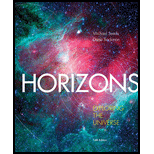
Horizons: Exploring the Universe (MindTap Course List)
14th Edition
ISBN: 9781305960961
Author: Michael A. Seeds, Dana Backman
Publisher: Cengage Learning
expand_more
expand_more
format_list_bulleted
Textbook Question
Chapter 1, Problem 7P
If the
Expert Solution & Answer
Trending nowThis is a popular solution!

Students have asked these similar questions
1.34 light-years to miles (a light-year is an astronomical measure of the distance traveled by light in a year, or 365 days; the speed of light is 2.998 × 10^8 m ;1 km = 0.6125 mi) Part 2 of 3 mi Be sure your answer has the correct number of significant digits. 30.0 yd to centimeters (1 in = 2.54 cm) 2743.2 cm Part 3 of 3 Be sure your answer has the correct number of significant digits. 3.4×1010 cm S to ft X S (1 in = 2.54 cm)
A light-year (ly) is the distance light travels in one year (at speed of 2.998 ×× 108 m/sm/s ). An astronomical unit (AU) is the average distance from the Sun to Earth, 1.50 ×× 108 km. 1 year = 3.156 ×× 107 s.
How many meters are there in 1.70 ly?
Express your answer using three significant figures. Express in scientific notation!
1.70 ly = _________________m
How many AU are there in 1.70 ly light-year?
Express your answer using three significant figures. Express in scientific notation!
1.70 ly = _________________AU
light travels at a rate of 1.86x10^5 miles per second. how far does light travel in one minute (6.0x10^1 seconds)?
Chapter 1 Solutions
Horizons: Exploring the Universe (MindTap Course List)
Ch. 1 - What is the largest dimension of which you have...Ch. 1 - What is the difference between our Solar System,...Ch. 1 - Why are light-years more convenient than miles,...Ch. 1 - Why is it difficult to detect planets orbiting...Ch. 1 - Prob. 5RQCh. 1 - What is the difference between the Milky Way and...Ch. 1 - What are the largest known structures in the...Ch. 1 - Prob. 8RQCh. 1 - How Do We Know? How does the scientific method...Ch. 1 - You and three of your friends have won an...
Ch. 1 - Think back to the last time you got a new phone...Ch. 1 - The diameter of Earth across the equator is 7928...Ch. 1 - The diameter of the Moon across its equator is...Ch. 1 - One astronomical unit is about 1.50108 km. Explain...Ch. 1 - Venus orbits 0.72 AU from the Sun. What is that...Ch. 1 - Light from the Sun takes 8 minutes to reach Earth....Ch. 1 - The Sun is almost 400 times farther from Earth...Ch. 1 - If the speed of light is 3.00105 km/s. how many...Ch. 1 - How long does it take light to cross the diameter...Ch. 1 - The nearest large galaxy to our n is about 2.5...Ch. 1 - How many galaxies like our own would it take Laid...Ch. 1 - In Figure 1-4, the division between daylight and...Ch. 1 - Prob. 2LTLCh. 1 - Prob. 3LTLCh. 1 - Prob. 4LTL
Knowledge Booster
Learn more about
Need a deep-dive on the concept behind this application? Look no further. Learn more about this topic, physics and related others by exploring similar questions and additional content below.Similar questions
- The distance from the Sun to the nearest star is about 4 1016 m. The Milky Way galaxy (Fig. P1.31) is roughly a disk of diameter 1021 in and thickness 1019 m. Find the order of magnitude of the number of stars in the Milky Way. Assume the distance between the Sun and our nearest neighbor is typical. Figure P1.31 The Milky Way galaxy.arrow_forwardThe meter was redefined as a reference to Earth, then to krypton, and finally to the speed of light. Why do you think the reference point for a meter continued to change?arrow_forwardThe speed of light is 2.998 × 108 m/s. One light-year is the distance that light travels in one year. One Astronomical Unit (AU) is 1.50 × 108 km. (a) How many meters are in 1.0 light-year? (b) How many meters are in 1.000 light-year? (c) How many AU are in 1.00 light-year? (d) What is the speed of light in AU/h?arrow_forward
- How many miles does light travel in one hour? The speed of light is 1.86x10^5 miles per second.arrow_forwardThe speed of light in a vacuum is 2.998×10^8 m/s. What is its speed in kilometers per hour (km/h)? What is its speed in miles per minute (mi/min)?arrow_forwardA light-year is the distance that light can travel in one year. Similarly, we can define a light-second, light-day, etc. as the distance that light can travel in other time intervals. Calculate the distance represented by each of the following: (Assume that the speed of light is 3 × 108 m/s). 1. 4 light-seconds 2. 3 light-minutes 3. 2 light-days 4. 2 light-days, but this time answer in miles (enter just the number with no units)arrow_forward
- Convert to SI and write in scientific notation: 1) 1.282 light-seconds to m 2)1 acre to m2arrow_forwardA light-year is the distance light travels in one year at speed =2.998*10^8m/s a) How many inches are there in 1.00 light-year? (b) The parsec is an astronomical unit of length approximately equal to 3.08×1016 m. How many light-years are there in 1.00 parsec?arrow_forwardUsing a single dimensional equation, estimate the number of steps it would take a person with a step length of 2.65 ft to walk from the Earth to Alpha Centauri a distance of 4.37 light-years. The speed of light is 1.86282 x 105 miles/s. Number of Steps = Enter your answer in accordance to the question statement x 1017arrow_forward
- A boat takes 3.00 hourshours to travel 50.0 kmkm down a river, then 6.10 hourshours to return. How fast is the river flowing?arrow_forwardIn astronomy, distances are often expressed in light-years. One light-year is the distance traveled by light in one year. The distance to Alpha Centauri, the closest star other than our own sun that can be seen by the naked eye, is 4.3 light-years. Express this distance in meters.arrow_forwardA light-year (ly) is the distance light travels in one year (at speed of 2.998 ×× 108 m/sm/s ). An astronomical unit (AU) is the average distance from the Sun to Earth, 1.50 ×× 108 kmkm.1 yearyear = 3.156 ×× 107 ss. a. How many meters are there in 6.50 lyly ? Express your answer using three significant figures. b. How many AUAU are there in 6.50 lyly light-year? Express your answer using three significant figures.arrow_forward
arrow_back_ios
SEE MORE QUESTIONS
arrow_forward_ios
Recommended textbooks for you
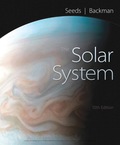
 Foundations of Astronomy (MindTap Course List)PhysicsISBN:9781337399920Author:Michael A. Seeds, Dana BackmanPublisher:Cengage Learning
Foundations of Astronomy (MindTap Course List)PhysicsISBN:9781337399920Author:Michael A. Seeds, Dana BackmanPublisher:Cengage Learning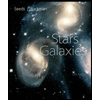 Stars and Galaxies (MindTap Course List)PhysicsISBN:9781337399944Author:Michael A. SeedsPublisher:Cengage Learning
Stars and Galaxies (MindTap Course List)PhysicsISBN:9781337399944Author:Michael A. SeedsPublisher:Cengage Learning AstronomyPhysicsISBN:9781938168284Author:Andrew Fraknoi; David Morrison; Sidney C. WolffPublisher:OpenStax
AstronomyPhysicsISBN:9781938168284Author:Andrew Fraknoi; David Morrison; Sidney C. WolffPublisher:OpenStax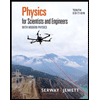 Physics for Scientists and Engineers with Modern ...PhysicsISBN:9781337553292Author:Raymond A. Serway, John W. JewettPublisher:Cengage Learning
Physics for Scientists and Engineers with Modern ...PhysicsISBN:9781337553292Author:Raymond A. Serway, John W. JewettPublisher:Cengage Learning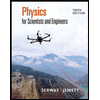 Physics for Scientists and EngineersPhysicsISBN:9781337553278Author:Raymond A. Serway, John W. JewettPublisher:Cengage Learning
Physics for Scientists and EngineersPhysicsISBN:9781337553278Author:Raymond A. Serway, John W. JewettPublisher:Cengage Learning


Foundations of Astronomy (MindTap Course List)
Physics
ISBN:9781337399920
Author:Michael A. Seeds, Dana Backman
Publisher:Cengage Learning

Stars and Galaxies (MindTap Course List)
Physics
ISBN:9781337399944
Author:Michael A. Seeds
Publisher:Cengage Learning

Astronomy
Physics
ISBN:9781938168284
Author:Andrew Fraknoi; David Morrison; Sidney C. Wolff
Publisher:OpenStax

Physics for Scientists and Engineers with Modern ...
Physics
ISBN:9781337553292
Author:Raymond A. Serway, John W. Jewett
Publisher:Cengage Learning

Physics for Scientists and Engineers
Physics
ISBN:9781337553278
Author:Raymond A. Serway, John W. Jewett
Publisher:Cengage Learning
Time Dilation - Einstein's Theory Of Relativity Explained!; Author: Science ABC;https://www.youtube.com/watch?v=yuD34tEpRFw;License: Standard YouTube License, CC-BY